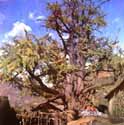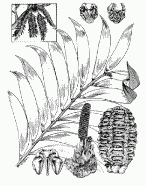
Ginkgo.

Zamia pseudoparasitica,
a Cycad
Common names
Gymnosperms.
Taxonomic notes
This database provides information on taxa belonging to the phylum Pinophyta. The Pinophyta has been subdivided along a variety of different lines and the recent flood of information on fundamental taxonomic characters (such as chloroplast DNA) has led to further revisions. One recent treatment (2) subdivides the division into 5 classes, 12 orders and 14 families. The principal point of contention between various schemes for dividing gymnosperms above the family level seems to be, at what point in the hierarchy are distinctions to be made. For example, this database draws no distinctions above the level of Order, assigning the gymnosperms to four Orders: Ginkgoales, Cycadales, Coniferales and Gnetales. This is quite a conservative classification, and is perhaps a bit dated, but it will do for now. In contrast, Reveal (2) raises the Gnetales to the level of superclass (Gnetophytina Cronquist, Takht. & Zimmerm. ex Reveal 1996) and raises its three families, Gnetaceae, Ephedraceae and Welwitschiaceae, to the level of Class. However, each Class then has a single order and a single family, so that both schemes agree in assigning all living gnetophytes to one of three families (indeed, three genera).
Regardless of the rank of the several taxa, the following table describes the relative hierarchy of gymnosperm taxonomy:
| Ginkgo (one species) | ||||
| Cycads | Cycas group (one family) Zamia group (one or two families) | |||
| Conifers | Pine-like conifers | Pine group (one family) | ||
| Sciadopitys group (one species, here placed in the cypresses) | ||||
| Podocarps (one or two families) | ||||
| Araucarias (one family) | ||||
| Cephalotaxus (one genus) | ||||
| Cypress group (one family) | ||||
| Yew-like conifers (one family) | ||||
| Gnetophytes | Gnetum (one genus) | |||
| Ephedra (one genus) | ||||
| Welwitschia (one species) | ||||
Although morphologically, ecologically and taxonomically diverse, and individually very numerous, the gymnosperms are not represented by a great many species. In this treatment there are 873 species (as of 29-Jan-1998), or about as many as may be found in the largest genera of flowering plants (such as Acacia). Of this total, one species represents the Ginkgos, 65 represent the Gnetophytes, 206 are Cycads, and the remaining 601 species are Conifers. At this time, those taxon figures are debatable within ±5-10%. There are not likely to be many more species discovered. There have lately been notable discoveries (Wollemia, discovered 1994 in Australia), and the affinity of certain cycads, some podocarps and many gnetophytes for tropical rainforest environments means that new discoveries may be made in those taxa as well. Conversely, there is a trend toward lumping among the familiar Cupressaceae and Pinaceae, as more taxa formerly seen as valid species are found to be geographical varieties or hybrids in the zone of overlap between congeners.
As a practical matter, this database generally treats species as valid if there is decent ground for debate as to whether a species is distinct or should be treated as a variety. This is often because, for many taxa, up-to-date taxonomic treatments are simply not available. Where I can find such a treatment, as in the recent treatment of Pinus by the Flora Neotropica, then I tend to give it considerable credence; but there are other taxa, such as Ephedra, that have not received monographic treatment since the 19th Century.
Description
Plants are classified into two large groups, vascular plants and nonvascular plants. Nonvascular plants lack tissues that have been specialized for the transport of water and nutrients between distant parts of the plant. They include all algae, mosses, and their allies. Vascular plants have such transport systems. They include the vast majority of familiar terrestrial plants and can be divided into three major groups according to major features of their reproductive systems. The simplest and oldest of these is the Pterophytina or ferns and fern allies. The next group is the Pinophyta or Gymnospermae, which are the focus of this presentation. The last and by far the largest group (about 250,000 described species), is the Angiospermae.
Gymnosperms are woody plants, either shrubs, trees, or, rarely, vines (some gnetophytes). They differ from flowering plants in that the seeds are not enclosed in an ovary but are exposed within any of a variety of structures, the most familiar being cones. A more anatomically detailed discussion of the comparative morphology of gymnosperms and related tracheophytes can be found in the On-Line Biology Book.
Range
Living gymnosperms are distributed worldwide (excepting Antarctica), with a majority, particularly the conifers, in temperate and subarctic regions (1).
Big Tree
Oldest
The age of a gymnosperm is usually difficult to determine. Precise numbers are only available if someone recorded the date of planting. Many trees have (approximately) annual rings, permitting approximate determination of the age of an individual, but in harsh environments many years may pass before the first ring is made. For example, Ken Lertzman (pers. comm. 1990) found mountain hemlock seedlings up to 18 years old (based on bud scar counts) that had yet to form their first ring. The greatest age known from ring counts is about 5000 years, for Pinus longaeva. Many other trees, including most tropical species, and all non-tree gymnosperms (Cycadales and Gnetales), do not have regular annual rings. Age estimates for such plants are usually based on extrapolation of observed growth rates. Such extrapolation may lead to estimation errors of several hundred percent (usually overestimation, because trees grow more slowly as they age). Many plants are clonal, so that numerous different individuals are genetically identical. Clone ages approaching 40,000 years have been estimated for Larrea tridentata, a shrub, and an age of 1,000,000 years has been proposed for Populus tremuloides, a tree. I know of no clone age estimates exceeding 1000 years for a gymnosperm, though such a situation is quite possible for the redwood, Sequoia sempervirens, which can sprout from fallen stems or cut stumps. The oldest gymnosperm clones are likely to be found among species prone to vegetative reproduction in an area of extraordinarily stable climate, such as cycads of the genus Encephalartos growing in South Africa.
Dendrochronology
Dendrochronology, the study of tree rings, is necessarily restricted to trees that form annual rings. This includes hundreds of species. Nearly all gymnosperms living in temperate or boreal climates have been investigated for use in dendrochronology, and most have proven suitable, with the exceptions found mainly in areas where extreme stress from cold, drought or other factors frequently prevents the formation of an annual ring. Tropical gymnosperms have been less widely studied, but generally, those growing in climates with pronounced wet and dry seasons form annual rings and those with year-round rainfall are not usable.
Ethnobotany
There are few gymnosperms that were not used by aboriginal peoples; the main exceptions seem to have been in areas where there were few or no people, or in tropical areas where angiosperm diversity far exceeded gymnosperm diversity. Two outstanding examples include:
- Cycads (Cycadales), Bunya pines (Araucaria bidwillii) and stone pines (Pinus subsection Cembroides), all of which produced edible nuts that were a staple food for local cultures.
- Western redcedar (Thuja plicata), which filled virtually all needs of Pacific Northwest Coast peoples except providing food.
Today, of course, gymnosperms provide the world with softwood lumber and with most of the wood pulp supply. Most of this timber comes from a handful of species, notably Pinus radiata, the most widely planted tree in the world, although it has one of the smallest natural distributions.
Remarks
Gymnosperm (Latin gymn-", naked"; Greek sperma, "seed"), common name for any seed-bearing vascular plant without flowers. The gymnosperms are the most ancient seed plants; they appear to have arisen from fern ancestors in the Devonian Period (1).
Citations
(1) "Gymnosperm," Microsoft Encarta 97 Encyclopedia.
(2) E-mail communication from James L. Reveal, 31-Dec-1998.
See also the references list for a fairly extensive (and growing) list of sometimes-annotated citations, and White 1994 for a beautifully illustrated account of the fossil origins of the major gymnosperm and angiosperm groups.
[Home]
This page is from the Gymnosperm Database
URL: http://www.geocities.com/RainForest/Canopy/2285/pinophyta.htm
Edited by Christopher J. Earle
E-mail:earlecj@earthlink.net
Last modified on 8-Apr-1999

